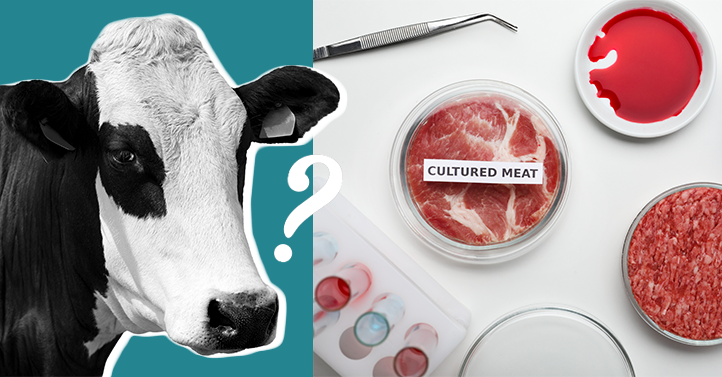Haute cuisine, nouvelle cuisine, fusion cuisine…lab-grown meat?
The latter may not conjure up images of Michelin stars, but lab-grown meat — more commonly known as “cultured meat” — is being touted far and wide as potentially the next big thing. But what exactly is it, and how is it made?
“Cultured meat is created by harvesting muscle cells from a living animal,” says Yann Pencole, Director of Consumer Products for our management consulting practice. The cells are then fed and nurtured so they multiply to create muscle tissue, which is the main component of the meat we eat.
Despite the recent tsunami of positive press about cultured meat, Pencole isn’t necessarily convinced. “While it’s extremely attractive to think about using microscopic cells to make a huge dent in many of the world’s most vital problems, the international scientific community is far more reserved about the benefits of cultured meat,” he says. “The data is not in as to whether cultured meat will indeed offer realistic solutions, nor is it yet completely clear as to which way the cost-benefit balance will tip.”
Nevertheless, startups are banking on the future of cultured meat, with the number of companies increasing from just four in 2016 to 60 in 2020. Investments in the cultured-meat segment have also grown dramatically, totaling $360 million in 2020, a six-fold increase from 2019.
WHY IT COULD BE WONDROUS
On paper, cultured meat does appear miraculous. According to estimates, livestock accounts for approximately 14.5% of total greenhouse gas emissions globally, with roughly two-thirds of those emissions coming from cattle livestock. Switching to cultured meat could reduce these emissions by up to 96% — a tremendous contribution toward counteracting global warming and climate change.
Cultured meat could also have a vastly positive impact on worldwide food security, including freeing up farmland. Reportedly, land would be used 60%-300% and an astronomical 2,000%-4,000% more efficiently if poultry and beef, respectively, were to be cultivated.
There are also health benefits associated with cultured meat in that it is antibiotic-free and could also be supplemented with vitamins and minerals not found in natural meat. Last, but not least, switching to cultured meat would save the lives of countless animals.
WHY IT COULD JUST BE A ‘NOVELTY’
In Pencole’s opinion, cultured meat is getting so much attention for a reason — “The novelty of this food is a wonderful topic for the media to cover,” he says — but news pieces are omitting some vital information. For example, using current technology, cultured meat consists mainly of muscle fibers — no blood vessels, no connective tissues, no bone. As a result, the range of nutrients differs from that in conventional meat — and, as Pencole notes, “No one really knows yet what this difference will mean for the human body.”
Another concern that’s being voiced is that if cultured meat proves to be much less expensive than traditional meat, people might eat more red meat. Research has shown that a diet high in red meat can raise the risk of type 2 diabetes, coronary heart disease, stroke, and certain cancers.
Besides nutritional concerns, there are daunting technical and regulatory limitations that will need to be resolved before commercial-level production of cultured meat can be achieved. Experts also debate the environmental benefits that are being promoted. In order to meet global demand for cultured meat, countless factories will be necessary, with each of them requiring tremendous energy and spewing CO₂ into the atmosphere…not that different than cattle belching methane — a potent greenhouse gas — into the vapors. Even worse, though, CO₂ takes much longer than methane to dissipate.
More so, there is the decidedly not-small detail of job and profit losses among farmers across the globe, all the way down the meat supply chain — and across the economy — if this little piggy does not go to market. And finally, the success of cultured meat ultimately boils down to whether it will or will not have the same drool factor for the average Joe hankering for a T-bone.
For information on other meat alternatives — namely, plant-based meat — refer to Kline’s Plant-Based Meat: Processing Alternatives and Ingredients Assessment or check out Pencole’s webinar on the subject here.
About this blog:
What Is Cultured Meat — And Is Anyone Really Going to Eat It? features insights from Yann Pencole, Director of Consumer Products for Kline’s management consulting practice.
Based in the London office, Pencole provides strategic business intelligence services to clients globally. Over the course of his career, he has managed and conducted studies on market entry and expansion strategy, due diligence and acquisition screening, manufacturing cost competitiveness, industry and competitor analysis, sourcing studies, and distributor searches. From an industry perspective, he has delivered successful projects to clients in beauty and personal care, healthcare, energy, petrochemical, mining, agrochemical, and construction.
Prior is an industrial engineer (he graduated from ICAM in France, Arts et Métiers) and holds a specialized Master’s degree in entrepreneurship from ESCP Europe (Paris campus). He is fluent in English and French and converses in Spanish and Japanese.
Press inquiries:
| Lance Debler |
| Content Marketing Manager |
| Kline & Co. |
| +1-973-435-3425 |
| Lance.Debler@klinegroup3dev.wpenginepowered.com |
| . |

